| Listing 1 - 10 of 20 | << page >> |
Sort by
|
Book
Year: 2000 Publisher: Antwerpen UA, Faculteit Wetenschappen, Departement Wiskunde-Informatica
Abstract | Keywords | Export | Availability | Bookmark
 Loading...
Loading...Choose an application
- Reference Manager
- EndNote
- RefWorks (Direct export to RefWorks)
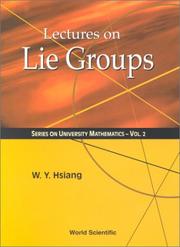
ISBN: 9810235291 9810235224 Year: 2000 Publisher: Hackensack World scientific
Abstract | Keywords | Export | Availability | Bookmark
 Loading...
Loading...Choose an application
- Reference Manager
- EndNote
- RefWorks (Direct export to RefWorks)
Lie groups. --- Lie groups --- 512.81 --- 512.81 Lie groups --- Groups, Lie --- Lie algebras --- Symmetric spaces --- Topological groups
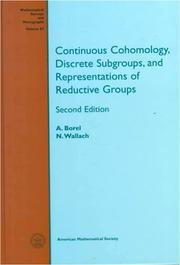
ISBN: 0821808516 9780821808511 Year: 2000 Publisher: Providence, R.I. American Mathematical Society
Abstract | Keywords | Export | Availability | Bookmark
 Loading...
Loading...Choose an application
- Reference Manager
- EndNote
- RefWorks (Direct export to RefWorks)
Homology theory --- Lie groups --- Representations of groups
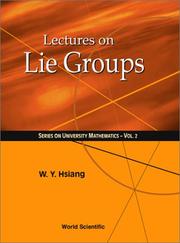
ISBN: 1281869627 9786611869625 9812384782 9789812384782 9810235224 Year: 2000 Volume: v. 2 Publisher: River Edge, NJ World Scientific
Abstract | Keywords | Export | Availability | Bookmark
 Loading...
Loading...Choose an application
- Reference Manager
- EndNote
- RefWorks (Direct export to RefWorks)
This invaluable book provides a concise and systematic introduction to the theory of compact connected Lie groups and their representations, as well as a complete presentation of the structure and classification theory. It uses a non-traditional approach and organization. There is a proper balance between, and a natural combination of, the algebraic and geometric aspects of Lie theory, not only in technical proofs but also in conceptual viewpoints.
Lie groups. --- Groups, Lie --- Lie algebras --- Symmetric spaces --- Topological groups
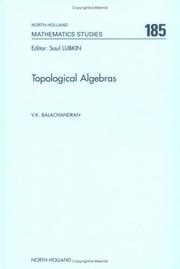
ISBN: 9780444506092 0444506098 9780080543086 0080543081 1281038784 9786611038786 Year: 2000 Publisher: Amsterdam ; New York : Elsevier,
Abstract | Keywords | Export | Availability | Bookmark
 Loading...
Loading...Choose an application
- Reference Manager
- EndNote
- RefWorks (Direct export to RefWorks)
This book consists of nine chapters. Chapter 1 is devoted to algebraic preliminaries. Chapter 2 deals with some of the basic definition and results concerning topological groups, topological linear spaces and topological algebras. Chapter 3 considered some generalizations of the norm. Chapter 4 is concerned with a generalization of the notion of convexity called p-convexity. In Chapter 5 some differential and integral analysis involving vector valued functions is developed. Chapter 6 is concerned with spectral analysis and applications. The Gelfand representation theory is the subject-mat
Algebra --- Topological groups. Lie groups --- Topological algebras. --- Functional analysis.

ISBN: 3540505857 9783540505853 Year: 2000 Volume: 21 Publisher: Berlin: Springer,
Abstract | Keywords | Export | Availability | Bookmark
 Loading...
Loading...Choose an application
- Reference Manager
- EndNote
- RefWorks (Direct export to RefWorks)
Ordered algebraic structures --- 512.81 --- Lie groups --- 512.81 Lie groups --- Lie, Algèbres de --- Lie, Groupes de

ISBN: 0387989633 1461270421 1461212022 Year: 2000 Publisher: New York, N.Y. Springer
Abstract | Keywords | Export | Availability | Bookmark
 Loading...
Loading...Choose an application
- Reference Manager
- EndNote
- RefWorks (Direct export to RefWorks)
Written by the recipient of the 1997 MAA Chauvenet Prize for mathematical exposition, this book tells how the theory of Lie groups emerged from a fascinating cross fertilization of many strains of 19th and early 20th century geometry, analysis, mathematical physics, algebra and topology. The reader will meet a host of mathematicians from the period and become acquainted with the major mathematical schools. The first part describes the geometrical and analytical considerations that initiated the theory at the hands of the Norwegian mathematician, Sophus Lie. The main figure in the second part is Weierstrass'student Wilhelm Killing, whose interest in the foundations of non-Euclidean geometry led to his discovery of almost all the central concepts and theorems on the structure and classification of semisimple Lie algebras. The scene then shifts to the Paris mathematical community and Elie Cartans work on the representation of Lie algebras. The final part describes the influential, unifying contributions of Hermann Weyl and their context: Hilberts Göttingen, general relativity and the Frobenius-Schur theory of characters. The book is written with the conviction that mathematical understanding is deepened by familiarity with underlying motivations and the less formal, more intuitive manner of original conception. The human side of the story is evoked through extensive use of correspondence between mathematicians. The book should prove enlightening to a broad range of readers, including prospective students of Lie theory, mathematicians, physicists and historians and philosophers of science.
Topological groups. Lie groups --- Lie groups --- History. --- Group theory. --- Group Theory and Generalizations. --- Groups, Theory of --- Substitutions (Mathematics) --- Algebra
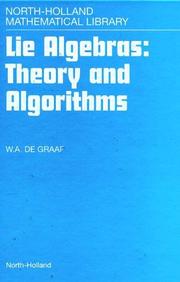
ISBN: 0444501169 9780444501165 9780080535456 0080535453 1281048259 9786611048259 Year: 2000 Volume: v. 56 Publisher: New York ; Amsterdam : Elsevier,
Abstract | Keywords | Export | Availability | Bookmark
 Loading...
Loading...Choose an application
- Reference Manager
- EndNote
- RefWorks (Direct export to RefWorks)
Differential topology --- Lie algebras. --- Root systems (Algebra) --- Lie algebras --- 512.81 --- 512.81 Lie groups --- Lie groups --- Algebras, Lie --- Algebra, Abstract --- Algebras, Linear --- Systems of roots (Algebra)
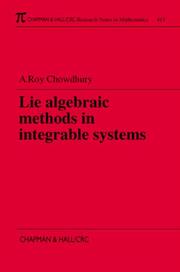
ISBN: 1584880376 Year: 2000 Publisher: Boca Raton, Fla Chapman & Hall/CRC
Abstract | Keywords | Export | Availability | Bookmark
 Loading...
Loading...Choose an application
- Reference Manager
- EndNote
- RefWorks (Direct export to RefWorks)
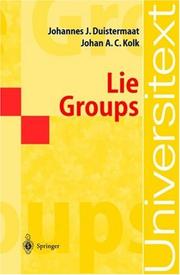
ISBN: 3540152938 3642569366 9783540152934 Year: 2000 Publisher: Berlin: Springer,
Abstract | Keywords | Export | Availability | Bookmark
 Loading...
Loading...Choose an application
- Reference Manager
- EndNote
- RefWorks (Direct export to RefWorks)
This book is devoted to an exposition of the theory of finite-dimensional Lie groups and Lie algebras, which is a beautiful and central topic in modern mathematics. At the end of the nineteenth century this theory came to life in the works of Sophus Lie. It had its origins in Lie's idea of applying Galois theory to differential equations and in Klein's "Erlanger Programm" of treat ing symmetry groups as the fundamental objects in geometry. Lie's approach to many problems of analysis and geometry was mainly local, that is, valid in local coordinate systems only. At the beginning of the twentieth century E. Cartan and Weyl began a systematic treatment of the global aspects of Lie's theory. Since then this theory has ramified tremendously and now, as the twentieth century is coming to a close, its concepts and methods pervade mathematics and theoretical physics. Despite the plethora of books devoted to Lie groups and Lie algebras we feel there is justification for a text that puts emphasis on Lie's principal idea, namely, geometry treated by a blend of algebra and analysis. Lie groups are geometrical objects whose structure can be described conveniently in terms of group actions and fiber bundles. Therefore our point of view is mainly differential geometrical. We have made no attempt to discuss systematically the theory of infinite-dimensional Lie groups and Lie algebras, which is cur rently an active area of research. We now give a short description of the contents of each chapter.
512.8 --- Lie groups, Lie algebras --- Lie groups --- Mathematics --- Physical Sciences & Mathematics --- Calculus --- Lie groups. --- Groups, Lie --- Lie algebras --- Symmetric spaces --- Topological groups --- Group theory. --- Topological groups. --- Group Theory and Generalizations. --- Topological Groups, Lie Groups. --- Groups, Topological --- Continuous groups --- Groups, Theory of --- Substitutions (Mathematics) --- Algebra --- Lie, Groupes de
| Listing 1 - 10 of 20 | << page >> |
Sort by
|

 Search
Search Feedback
Feedback About UniCat
About UniCat  Help
Help News
News